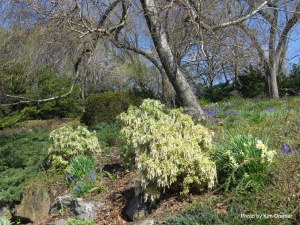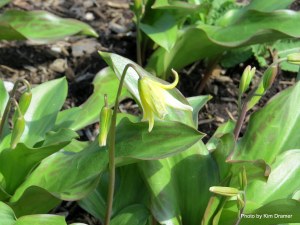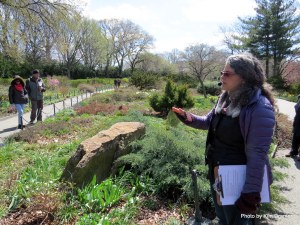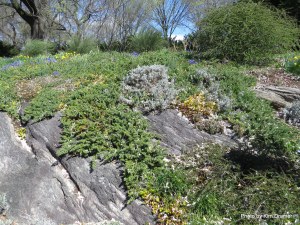THE WASTELAND by T.S. Eliot
April is the cruelest month, breeding
Lilacs out of the dead land, mixing
Memory and desire, stirring
Dull roots with spring rain
Ronda Brands, Garden Designer and Horticulturist, might argue that T.S. Eliot wasn’t much of a gardener. Her April garden tour in Fort Tryon Park attracted a crowd of New Yorkers eager to share the first signs of spring.
Ronda’s tour focused on the three acres of Fort Tryon Park known as the Heather Garden. This swathe of garden is planted over 500 varieties of trees, shrubs, perennials and bulbs, including dozens of varieties of heaths and heathers that combine to form a sweep of changing colors and textures in each season. During early spring, the blooming heaths are a signature plant of the Heather Garden. They put on a show of waves of pink and white in partnership with the vivid purples and yellows of early spring bulbs. It’s a signal that a happy change has arrived to bring New Yorkers out of both their apartments and the winter doldrums, and into New York City’s most beautiful park.
Heaths (Erica species and cultivars), usually flower from mid-winter to early spring. These are followed by heathers (Calluna vulgaris cultivars), which take over in mid-summer. Working over the years with the Northeast Heather Society, the gardeners and designers have carefully selected plants have been planted to provide year-round interest of blooms and foliage color in the garden. Both heaths and heathers are evergreens, with foliage of green, yellow and red that might turn silver, copper, red or even chocolate during winter months. The seasonal change is a particular joy for Ronda, who was called to the Garden by the Fort Tryon Trust in 2009 as design partner to Lynden B. Miller, New York City’s icon of public garden design, to reinvigorate the Garden and develop a plan for sustaining it for the long term.

The shrub Andromeda (Pieris Japonica) has foliage that changes color throughout the year. In early spring, the dark green foliage appears with long, dangling clusters of white flowers.
Lynden Miller and Ronda Brands, fabulous New York women, created a fabulous design for a fabulous garden. They decided to edit the garden carefully to preserve the spirit of the original plan by the Olmsted Brothers, whose father was the designer of Central Park. They also decided to capitalize on its romantic and rustic feel, taking full advantage of the sloped, rocky topography. Their design features an overarching feel with carefully selected vignettes of plants punctuating the cohesive rivers of perennials.
The park is located on a ridge near the highest point on Manhattan. The area was known as Chquaesgeck by the local Lenape tribe, and was called Lange Bergh (Long Hill) by Dutch settlers. Visitors enjoy sweeping views of the Hudson River. These stretches of water are repeated in the rivers of plants that give the garden both unity and movement. Plants, foliage, structures and shape move the eye through space.
Twitter called the park “The Happiest Spot in Manhattan,” yet it remains one of Manhattan’s best kept secrets. At 67 acres, Fort Tryon Park offers tranquility and calm in a tapestry of plants and flowers over 200 feet above the Hudson River. It is the city’s largest public garden and is a city, state and national landmark. Local resident Gabe Kirchheimer has photographed every flower in the park and produced Fort Tryon Park Flowers his own independent and amazing web site of what he calls “The Flower Capital of Manhattan. ” The photographer organizes the flowers by season using over 1,000 photographs.
The garden requires a significant amount of skilled maintenance, provided by Parks Department gardeners. Each week, a legion of fabulous New York women (and men!) from the neighborhood come together to work as volunteers in the garden. Speaking of the long flower beds, Ronda says (with great admiration and affection): The volunteers weed, and weed, and weed from one end of the bed to the other. When they reach the end, they return to the beginning and start weeding again.” Fabulous New York women (and men)!
Fort Tryon Park Trust offers free tours of the Heather Garden on the first Sunday of every month. The Trust raises endowment to help support the park and its year-round horticultural maintenance and offers more than 300 free programs annually, including environmental education programs for children.




